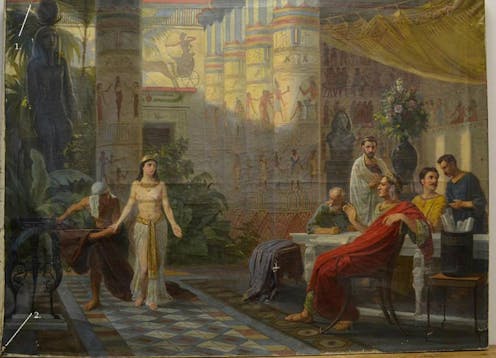What was the deal with Julius Caesar and Cleopatra’s ‘situationship’?
- Written by Charlotte Dunn, Lecturer in Classics, University of Tasmania

The Egyptian queen Cleopatra is often associated with glamorous beauty routines, deadly snake bites, lavish banquets and torrid affairs with some of the most notorious men in Roman history.
One such (very public) affair was with Roman leader Julius Caesar.
But their “situationship” was complex. This doomed romance ended abruptly in 44 BCE when Caesar was quite literally stabbed in the back (and from all sides) by his enemies in Rome. And she pretty soon hooked up with one of his closest allies.
Queen meets consul
When Caesar met Cleopatra, he was was 52 and had a wife back in Rome. But something about the 21-year-old Cleopatra caught his eye.
Perhaps it was her charming banter and impressive mind. The ancient author Plutarch reports Cleopatra was an irresistible conversation partner, and fluent in nine languages.
Things really got started when Caesar got involved in a family feud involving Cleopatra and her royal relatives.
Cleopatra came from a long line of dramatic and ruthless kings and queens, which we now call the Ptolemies.
The Ptolemies had ruled Egypt since about 305 or 304 BCE. They didn’t always get along but they were very close. As in, genetically close.
The Ptolemies had practised brother-sister marriages (and other in-the-family marriages as well) for several generations.
According to this tradition, Cleopatra was probably married to her ten-year-old brother Ptolemy XIII when their father died and they became co-rulers of Egypt.
So in pursuing Caesar, you might say Cleopatra was going against the family trend by dating outside her siblings.
Cleopatra’s union with her little brother was not a happy one: the young Ptolemy, alongside his advisors, had managed to run Cleopatra out of Egypt, wanting to rule the kingdom without her interfering.
While Cleopatra was busy raising an army to reclaim her place on the throne, Caesar arrived at the royal palace at Alexandria in 48 BCE.
Caesar had his own political woes. He was in the middle of a civil war, and was pursuing his rival Gnaeus Pompey (also known as Pompey the Great) after defeating his army in Greece.
Ptolemy, completely misreading the situation, greeted Caesar with a gruesome and unexpected gift: Pompey’s severed head.
Outraged and disgusted, Caesar demanded Cleopatra and her brother reconcile, but Cleopatra had other plans.
Plutarch says she hid herself in a bed sack and got smuggled into the palace to meet and charm Caesar.
Was it true love?
The young Cleopatra was ambitious, and there’s no denying a connection with Caesar was politically advantageous.
Caesar also had plenty of other affairs, including one with another queen, Eunoë of Mauretania.
But there may well have been a true connection with Cleopatra. Caesar, after all, was also very well educated and ruthlessly ambitious, and the ancient author Suetonius states Cleopatra was Caesar’s most passionate love affair.
But whatever sparks flew, Cleopatra couldn’t fully escape her family responsibilities.
Caesar put her back on the throne but arranged for her to marry her youngest brother, Ptolemy XIV after her previous brother-husband (Ptolemy XIII) drowned.
Nothing spells romance like your lover ordering you to marry your 12-year-old brother, but Cleopatra needed Caesar’s help to secure her position on the throne.
Being older and ambitious, she seemingly had no trouble taking the lead in running their kingdom, pushing Ptolemy XIV to one side.
A luxurious cruise down the Nile
Some sources say Cleopatra and Caesar celebrated their success at smoothing things over in Alexandria by taking a luxurious cruise down the Nile, accompanied by 400 ships.
This promoted their partnership and alliance, and by this time there was something else to celebrate: Cleopatra was pregnant with Caesar’s son, something she wanted to advertise as the future of her dynasty.
Cleopatra and Caesar’s son was nicknamed Caesarion, meaning “little Caesar”, although he is also known as Ptolemy Caesar or Ptolemy XV.
Caesarion’s existence was a bit of a problem. Caesar probably acknowledged the boy as his son, but Roman law did not, because Roman men were not allowed to marry foreign women.
There was also of course the matter that Caesar was still married at the time, to a Roman woman named Calpurnia.
The fiercely republican Romans of this era did not have much love for monarchy, and Caesar’s dalliance with Cleopatra probably made his fellow Romans even more suspicious about his own grand plans.
When in Rome
Despite many Romans disapproving of the relationship, the Egyptian queen spent about 18 months living on Caesar’s estate in Rome.
While there, Caesar seems to have done nothing to dispel the rumours about his situationship with Cleopatra, and he may have even dedicated a golden statue of Cleopatra as Venus in the temple of Venus Genetrix.
The famous orator Cicero was not impressed, writing in a letter to a friend “reginam odi” or “I hate the queen.”
After Caesar’s assassination, Cleopatra returned to Egypt.
But she soon began a love affair with Marc Antony, Caesar’s right hand man and would-be successor to his power, if 19-year-old Octavian (who would eventually become the first emperor Augustus) had not been named heir in Caesar’s will.
Antony and Cleopatra’s relationship flourished, but ended in tragedy when Octavian’s political rivalry with Antony intensified, and Octavian used their relationship as fuel for anti-Antony propaganda.
The lovers were eventually pursued and defeated by Octavian’s forces. Both took their own lives – he by stabbing himself with a sword and she, according to one version of the tale, by compelling a snake to bite her.
Authors: Charlotte Dunn, Lecturer in Classics, University of Tasmania
Read more https://theconversation.com/what-was-the-deal-with-julius-caesar-and-cleopatras-situationship-237868





